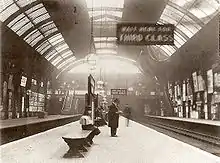Circle route
A circle route (also circumference, loop, ring route, ring line or orbital line) is a public transport route following a path approximating a circle or at least a closed curve.
.jpg.webp)

Definition
The expression "circle route" may refer in particular to:
- a route orbiting a central point, commonly the central business district (CBD) in a city or large town
- a route running in approximately a circular path from a point near the centre of a city or town out to a peripheral point and back again
- a feeder route running from an interchange station around a neighbourhood or suburb in approximately a circle
Typical characteristics
Typically, a circle route will connect at several locations with one or more cross-city routes or radial routes offering services in a straighter line into or out of a city or town centre. When a circle route orbits a central business district in a large arc, it will often provide transverse (or lateral) links between suburbs or satellites, either on its own or in combination with other routes, such as Seoul Subway Line 2, the busiest line in the Seoul Metropolitan Subway network, and formerly the longest circle metro line in the world from 1984–2013. Such connections assist travellers by reducing travel times, avoiding congested centres, and sometimes reducing the number of transfers. Similar benefits may also be achieved by half-circle routes or peripheral cross-city routes, such as Osaka Higashi Line, Musashino Line and Copenhagen S-Train Line F.
Notable circle routes
The oldest circular rapid transit line was London's Inner Circle, today the Circle line of the London Underground, which was completed in 1884, operated by two separate companies.[1] The route chosen forms the general border of what is today central London. This was followed by the Glasgow Subway which opened in 1896, with the system unchanged to this day. In Moscow Metro, a railway from 1908 was reopened as a passenger line in 2016. More recently, line 3 of the Copenhagen Metro opened in 2019, connecting the city centre to the northern and eastern suburbs. In some cities such as Paris, where lines 2 and 6 encircle the city, multiple services together can effectively form a circular route.
Circle routes can also be found in many commuter rail networks, namely in Sydney and Melbourne, with Sydney's City Circle being built in 1926 and Melbourne's City Loop in 1978. Further examples are the Osaka Loop Line for the JR West Urban Network serving the Kyoto-Osaka-Kobe conurbation and the Yamanote Line for the JR East Greater Tokyo commuter rail network.
See also
- Ring road, a road with a circular route
References
- "How old is the Circle line?". The Telegraph. Telegraph Media Group. 6 October 2016. Retrieved 13 October 2019.
- "Route Planning". Urban Bus Toolkit. World Bank Group / Public-Private Infrastructure Advisory Facility. Retrieved 27 October 2012.
External links
- metrobits.org: Metro Rings and Loops – includes a list of commuter rail and rapid transit circle routes worldwide